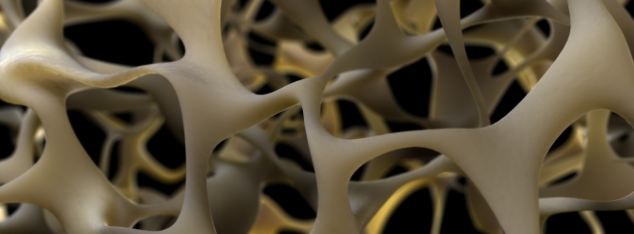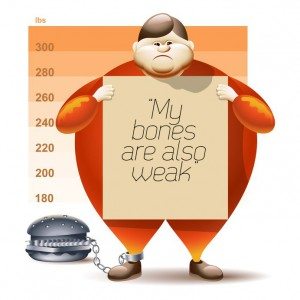In a recent study completed by the Harvard Medical School, researchers discovered that obesity actually increases the risk of developing osteoporosis, instead of reducing it, as was previously thought.
Using a proton magnetic resonance spectroscopy (MRS), researchers scanned the bones of 106 obese men and women between the age of 19-45 to explore the impact that being excessively fat has on bone health. They were astounded at the results!
In healthy adults, the activity of the bone producing cells (osteoblasts) and the bone destroying cells (osteoclasts) remain fairly constant. In obese individuals however, researchers now believe that excessive levels of fat exerts a stimulatory effect on the osteoclasts, which triggers the decay and destruction of healthy bone tissue. Additionally, this increased storage of fat within the bone marrow is also believed to impede the action of the osteoblast cells, further reducing bone mineral density (BMD).
Previously, experts believed that the protective effects of the hormone oestrogen, which is actually produced by fat cells (adipocytes), would help to promote healthy skeletal tissue. We know that oestrogen deficiency in women post menopause accelerates bone loss, so it seemed logical to assume that the converse would help to increase bone strength. In healthy individuals, oestrogen increases the skeleton’s uptake of calcium and consequently increases the strength and density of the bones. In obese people however, the effects of oestrogen appears to be insufficient to overcome fat bone syndrome.
Scientists also previously believed that that because obese people are invariably heavier than non-obese individuals, their bones would be loaded to a much greater extent, and that osteoporosis is unlikely to be a serious co-morbidity for this population.
Miriam Bredella, an associate professor at Harvard Medical School and lead on this study states that “obesity was previously believed to protect the skeleton against a loss of BMD but now we are finding the contrary is true”. She also states that “those who have an apple-shaped body, that is those who carry the majority of their weight around the abdomen, are likely to be at the greatest risk”.
It is in the bone marrow where the bone forming osteoblast cells live and work. When this space is occupied by fat, the activity of these bones literally grinds to a halt and bones become weaker and more porous. When bones are filled with fat and not calcium, their strength is reduced considerably and they are unable to perform many of their key roles, including supporting the body, protecting organs and even producing blood cells.

In the UK, we are literally on the cusp of an obesity epidemic similar to that already plaguing the US. We have children as young as 8 presenting with the onset of high blood pressure (hypertension) as a result of their spiraling weight. There are no signs that these trends will reverse anytime soon.
Currently in the UK there are is an estimated 3 million people suffering from osteoporosis, most of which are frail older adults with very low body weights. According to the NHS Information Centre, in 2011 just under a quarter of men (24%) and just over quarter of women (26%) were obese, and 41% of men and 33% of women were overweight. Based on this evidence, it is likely that we will see a much stronger prevalence of both of these diseases in the future.
Reference
Miriam A. Bredella, Corey M. Gill, Anu V. Gerweck, Melissa G. Landa, Vidhya Kumar, Scott M. Daley, Martin Torriani, and Karen K. Miller. Ectopic and Serum Lipid Levels Are Positively Associated with Bone Marrow Fat in Obesity Radiology. Radiology, 2013; DOI: 10.1148/radiol.13130375


